
There has always been a lot of speculation as to how black holes actually form when a massive star dies. It is generally accepted that any star over about 20 solar masses (20 times more massive than our sun) will end it’s life in a supernova and a black hole will be left behind. But how does a black hole actually form?
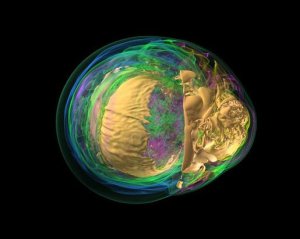
In recent years supercomputers have become more and more powerful, which has allowed modeling of supernovae to become possible. Until recently we haven’t been able to create a successful supernova simulation for stars heavier than the 8-10 solar mass range, as stars larger than this have heavier cores when the supernova occurred – taking away too much kinetic energy from the explosion. A heavier core has a stronger gravitational pull on falling matter, thus a larger escape velocity; more than what could give a successful supernova explosion in computer models.
What is being modeled is a classical core collapse supernova, which is where the iron core goes through a sudden collapse due to the star producing more energy. When the iron core shrinks into a proto-neutron star, gravity pulls the rest of the star in and it effectively bounces off of the solid proto-neutron star. This sends shock waves outwards from the core, blowing the star apart. As mentioned earlier, this was only successful in computer modelling in stars with a mass of 8-10 solar masses.
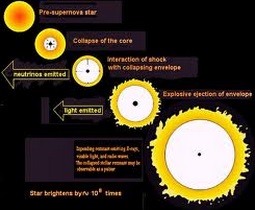
During a supernova almost all of the energy is converted directly into neutrinos so only a small amount is actually released in the explosion, this could potentially still be more energy than our sun will produce in its entire 10 billion year lifetime. With the constant failures of computer modelling it was decided that the neutrinos could help give an extra kick to the explosion and with the aid of faster supercomputers, more successful supernovae have now been modeled.
Let’s take this from the point at which the star begins to undergo a core collapse – when the star stops producing the energy that keeps gravity at bay. The iron core doesn’t collapse into a single entity, computer modelling suggests that it has both an inner and outer collapsing core with the inter core typically only being about 0.65 solar masses and the outer core taking up the rest. The collapsing core as a whole, even on a 40 solar mass star, only had an iron core of approximately 2-2.5 solar masses depending on the exact parameters used in the simulation.
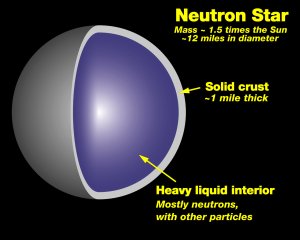
Unlike electron degeneracy we don’t know the thresholds of neutron degeneracy, a white dwarf will collapse at 1.44 solar masses or more but we don’t know at what mass a neutron star will collapse into a black hole. The current generally accepted mass is ~3 solar masses, this means that a 40 solar mass star will not have a core heavy enough to directly form a black hole at the time of core collapse. As the star becomes heavier – 80 solar masses, for instance – it won’t have an iron core exceeding the size of a star with 40 times the combined mass of the sun. There are several reasons for this but that’s a story for another day.
The entire core collapse is expected to take about half a second, as the inner core collapses; with the outer core following soon after. The rest of the star is, of course, trailing behind both of these. As the inner and outer core meet, a lot of energy is released. This helps fuel the collapse further as more energy is put into the converting the protons and electrons into neutrons, a by-product of this reaction being the production of many, many neutrinos. It is also in this impact of the inner and outer core that many of the heavier elements seen in the universe are produced, as well as during the subsequent impact of the rest of the star falling into the core region.
As discussed in a previous article, the supernova then occurs, in part due to the inward falling matter colliding with the solar proto-neutron star core and also what is best described as the boiling of neutrinos against the infallible matter. It is currently thought that it is both of these processes working in conjunction that cause the vast amount of energy needed to blow the star into oblivion.
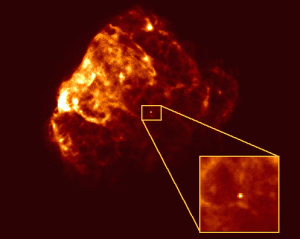
Now you might be wondering… What’s next? We’ve still got a 2.5 solar mass neutron star at the centre of a supernova explosion – with the rest of the star sailing off into the universe. Well, this isn’t quite the end. The interesting thing about the modelling of supernova explosions is that not all of the material actually gets dispersed in the explosion. This is how our 2.5 solar mass proto-neutron star becomes a black hole. Although the supernova may be successful, there can still be a considerable amount of material that didn’t create enough kinetic energy to escape the gravitational pull of the proto-neutron star.
This modelling explains why a 20 solar mass star that produces a proto-neutron star – generally with a mass less than 2 solar masses – can still form a black hole, probably not much over the 3 solar mass threshold (at least we think that is where the threshold lies). An 80 solar mass star may only have a proto-neutron star, with a mass of about 2.5-2.8 solar masses (from other simulations that were referred to within the thesis), but the black hole still tends to have at least 20 solar masses of material. There is not a great difference between proto-neutron star masses and normal ones, but there is a big difference between black hole masses, this is explained by the amount of material that isn’t able to escape the gravitational attraction (escape velocity) of the core.
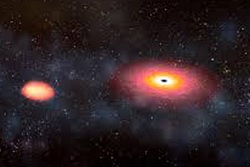
Interestingly, the amount of energy released in a 20 solar mass and an 80 solar mass star isn’t proportional to the 4x mass increase and, added to the increase of gravitational attraction, the larger the star – the less material is expelled into the universe. This isn’t entirely true, obviously more material is released into the universe, but a larger percentage of the ZAMS (zero age main sequence stars) mass eventually falls back onto the proto-neutron star.
This is why only a small difference in the mass of the proto-neutron star can, in the end, have such a large difference in the mass of the black hole. A larger percentage of a larger star won’t be dispersed during the supernova explosion than that of a smaller star. Ultimately however, this may all be wrong! We’re still not quite sure as to exactly what happens within a supernova. Other theories also include acoustic waves, or even incredibly strong magnetic fields at the core helping with the supernova, it could even be the addition of all of the above. Maybe something crazy and new is going on which defies all known physical laws! Only time (and faster supercomputers) will tell!